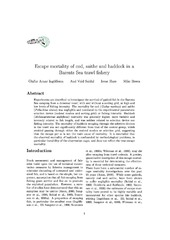Size selectivity and escape mortality of gadoid fish in the Barents Sea trawl fishery
Abstract
Responsible sheries management involve, among other things, operations to avoid catches of juvenile sh. Technical measures of shing gears to exclude small sh are thus generally regulated. Knowledge and control over the size selection characteristics of the shing gear are therefore required, and the escaping sh should survive for the size selection to be a meaningful action. This thesis consists of four papers that deal with size selectivity and escape mortality of cod (Gadus morhua), haddock (Melanogrammus aegle nus) and saithe (Pollachius virens) in the Barents Sea bottom trawl sheries. Our studies show that the trawl ground gears contribute to the overall size selectivity of bottom trawls. Netting bags were rigged underneath a commercial trawl with a rockhopper gear, along the shing line, to collect sh that passed beneath the trawl. Approximately one third of the cod, a quarter of the haddock and seven percent of saithe available to the trawl escaped below the shing line. Cod escape rates were highly length dependent with an estimated length at 50% retention (L50) of 38.5 cm and selection range (L75 − L25 = SR) of 34.1 cm. Length dependence was less pronounced for haddock, and the escape rate of saithe was not length dependent. Some of the sh had been overrun by the gear as evidenced by scale abrasions and video observations. The size selection of a bottom trawl for cod with the mandatory con guration of a sorting grid with 55 mm bar spacings and a 135 mm diamond mesh codend was compared to that of conventional codends of 135 and 155 mm mesh sizes. Previous indirect comparisons have indicated sharper selection (narrower SR) for sorting grids than conventional codends. Based on these comparisons, the use of grids was made mandatory in the Barents Sea bottom trawl shery for cod. Our experimental studies demonstrated no evidence that the grid and mesh combination has sharper selection than conventional codends. The introduction of the grid corresponded to approx. 20 mm increase in mesh size, from 135 mm to 155 mm. The L50 for the grid declined with increasing catch rates, but grid selection appeared less affected by seasonal variations in girth and sh condition than mesh selectivity. Mortality of cod, saithe and haddock that escaped through meshes and sorting grids were studied in four eld experiments. Cod and saithe mortality were negligible, suggesting that selection devices serve their purpose as conservation tools regarding these species. Haddock mortality was higher and inversely related to sh length. Their mortality could neither been shown to depend upon selection device nor shing intensity. There was, however, a considerable variation between replicates masking any such possible effects. It is concluded that the trawl passage, but not mesh and grid penetration is the ii primary cause of mortality. Injury analysis supports this suggestion. The mortality estimates were confounded by methodological problems. Potential sources of experimentally induced mortality were identi ed throughout the experiments and the methods subsequently improved. The confounding methodological effects are accounted for in a model describing haddock escape mortality.
